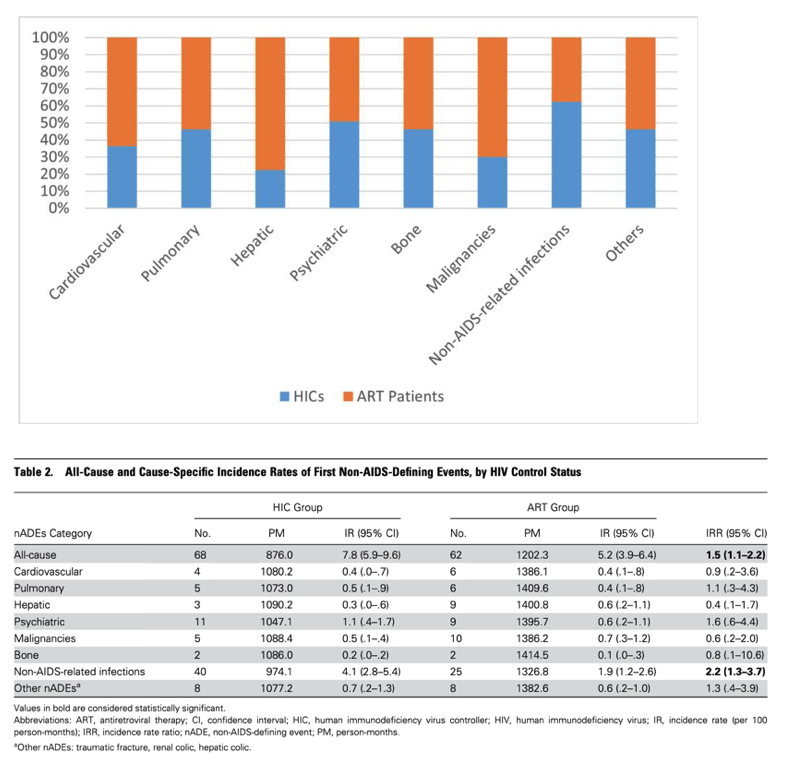| |
Comorbidities: HIV Controllers vs on ART
|
| |
| |
Download the PDF here
Our study shows that (1) HICs experienced 2 times more all-cause nADEs than ART-treated patients from the PRIMO cohort, (2) non-AIDS-related infections represented the most common type of nADE, and (3) age was the only independent factor associated with all-cause nADE occurrence, whereas immunovirological parameters were not significantly associated with nADE occurrence.
In conclusion, we report that in a large cohort of strictly defined untreated HIV controllers, the risk of nADEs is mainly linked with that of non-AIDS-defining infections. Age is a major factor involved in the risk of events, but the role of residual inflammation is still to be investigated. Studies aimed at measuring the effect of ART in HICs might consider clinical outcomes besides immune activation through a case-to-case approach.
the impact of ART on reducing the risk of nADEs beyond improvement in inflammatory biomarkers has not been firmly proven.
International guidelines recommend systematic and immediate initiation of antiretroviral therapy (ART) regardless of the presence or absence of symptomatology, CD4 T-cell count, or viral load (VL) level. This earliness includes many advantages such as the reduction of chronic systemic inflammation and immune activation [1, 2], which plays a major role in the occurrence of nADEs [3]. However, immunity is not fully restored for all patients [4]. Many markers of inflammation, which reflect chronic immune activation, remain higher than in the general population [5, 6]. Consequently, an excess risk of non-AIDS-defining events (nADEs) compared to the general population persists, such as malignancies; cardiovascular, liver, kidney, bone, and neuropsychiatric diseases; and a raised associated mortality, especially in patients with a CD4 count <500 cells/μL [7-9].
Figure 1. Distribution of specific-cause non-AIDS-defining events among all non-AIDS-defining events, in human immunodeficiency virus controller (HIC) and antiretroviral therapy (ART) patient groups.

Non-AIDS-Defining Events in Human Immunodeficiency Virus Controllers Versus Antiretroviral Therapy-Controlled Patients: A Cohort Collaboration From the French National Agency for Research on AIDS CO21 (CODEX) and CO06 (PRIMO) Cohorts
Open Forum Infectious Diseases February 2023
Abstract
Background
Low-grade chronic inflammation may persist in spontaneous human immunodeficiency virus controllers (HICs), leading to non-AIDS-defining events (nADEs).
Methods
Two hundred twenty-seven antiretroviral therapy (ART)-naive HICs (known human immunodeficiency virus type 1 [HIV-1] infection ≥5 years and at least 5 consecutive viral loads [VLs] <400 HIV RNA copies/mL) were compared with 328 patients who initiated ART ≤1 month after primary HIV infection diagnosis and had undetectable VL within 12 months following ART initiation for at least 5 years. Incidence rates of first nADEs were compared between HICs and ART-treated patients. Determinants of nADEs were assessed by using Cox regression models.
Results
All-cause nADEs incidence rates were 7.8 (95% confidence interval [CI], 5.9-9.6) and 5.2 (95% CI, 3.9-6.4) per 100 person-months among HICs and ART patients, respectively (incidence rate ratio [IRR], 1.5 [95% CI, 1.1-2.2]; adjusted IRR, 1.93 [95% CI, 1.16-3.20]). After adjustment for the cohort, demographic, and immunological characteristics, the only other factor associated with all-cause nADE occurrence was age ≥43 (vs <43) years at the beginning of viral control (IRR, 1.69 [95% CI, 1.11-2.56]). The most frequent events observed in the 2 cohorts were non-AIDS-related benign infections (54.6% and 32.9% of all nADEs, respectively, for HICs and ART patients). No differences in cardiovascular or psychiatric events were observed.
Conclusions
HICs experienced 2 times more nADEs than virologically suppressed patients on ART, mainly non-AIDS-related benign infections. Older age was associated with nADE occurrence, independent of immune or virologic parameters. These results do not argue in favor of expanding the ART indication for HICs but rather a case-by-case approach considering clinical outcomes such as nADEs besides immune activation.
|
|
| |
| |
|
|
|